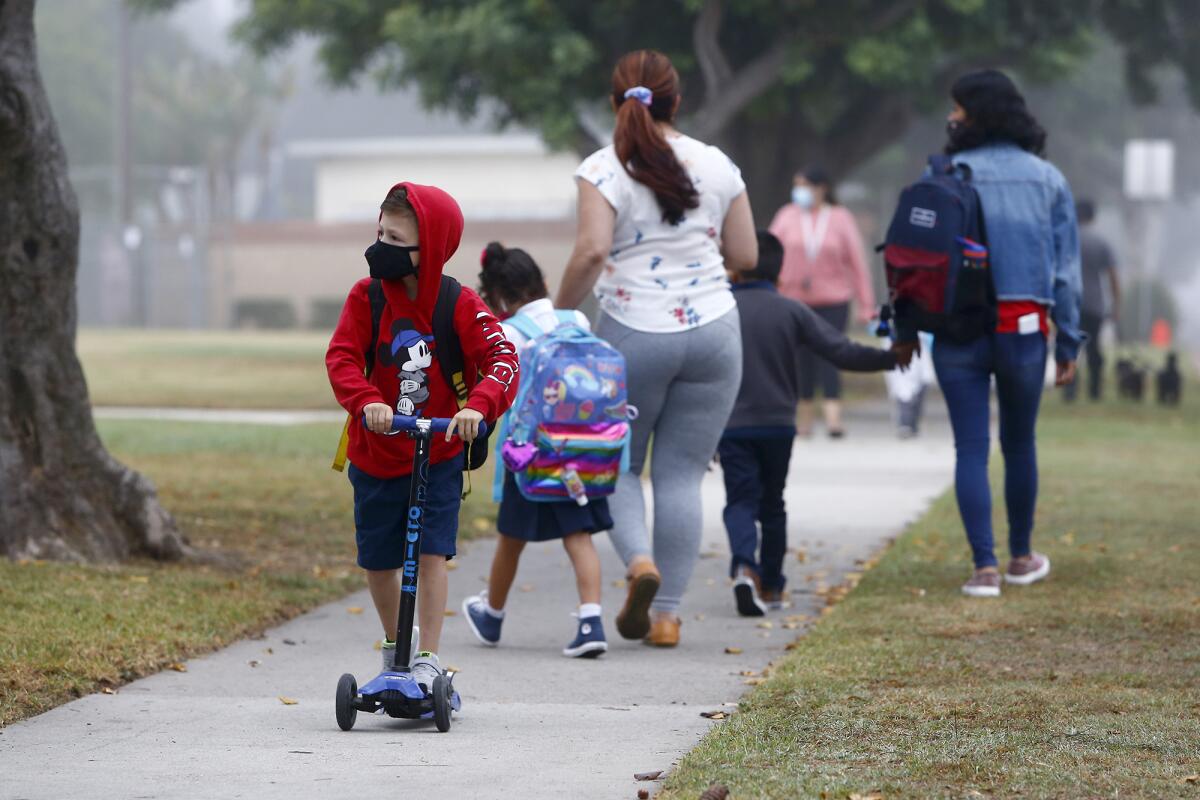How much learning loss have Newport-Mesa Unified students suffered during the pandemic?

- Share via
As the end of the school year draws closer, Newport-Mesa Unified School District officials are contemplating how much learning loss students have sustained during the pandemic and devising a plan to get kids back on track in the year ahead.
Trustees in a study session Tuesday attempted to understand how nearly a year of campus closures and reopenings, distance learning and modified school schedules that provide just a few hours of face time may be impacting K-6 learners and their ability to meet grade-level expectations.
Assistant Supt. John Drake shared reading assessment data from the beginning of the 2019-20 school year and compared it to similar benchmarks measured at the start of the current school year, when students already had months of distance learning under their belts.
Composite grade-level data indicated about 68% of kindergartners performed at or above standard reading levels last year, compared to 71% this year. Among first-graders, proficiency dropped from 62% going into 2019-20, to 52% at the start of this year. Second-graders remained steady at 77% proficiency.
“It could be that these second-graders did have a solid year and a half of instruction around these foundational reading skills, so had a better foundation to build on,” Drake surmised.
For students in third- through sixth-grade, Drake compared STAR reading assessment data collected midyear in 2019-20 with recent midyear data “hot off the presses.” Comparisons showed reading proficiency has dropped between 8% and 12% in those grades.
Reading assessment data showed 66% of Newport-Mesa Unified third-graders were reading at grade level last year, compared to just 56% this year. Fourth-graders dropped from 58% to 46% and fifth-graders from 52% to 42%.
Meanwhile, just half of sixth-grade students demonstrated grade-level reading comprehension this year, compared to 58% last year.
The baseline data points don’t provide much context as to what students are really experiencing in pandemic-era learning scenarios, officials clarified, but do indicate strategies for improving outcomes will be needed.
“It would be an understatement to say this pandemic has been challenging, I think, for all of us,” Drake told school board members. “Any way we slice the data in this broad brushstroke way … we have our work cut out for us.”
Similar indicators of students’ math performance were not immediately available, Drake said, as instructors have done fewer assessments during the pandemic to maximize mathematics instruction.
Instead, a group of educators gave a progress report on a recent collaboration with UC Irvine and the Orange County Department of Education that could advance mathematics instruction across Newport-Mesa Unified campuses.
In the 2018-19 school year, elementary school teachers began learning how to use Cognitively Guided Instruction in math classrooms. A student-centered approach, CGI aims to build on what students know and take advantage of their intuitive sense of numbers and solving programs to engage them in lessons.
Some in the program, such as Adams Elementary School first-grade teacher Michelle Sperling, have become math fellows committed to sharing what they’ve learned with colleagues to expand the model to other campuses and, eventually, subjects beyond math.
Sperling said the new way of teaching has freed her from rigid pacing guides and allowed her to work more from where her students are at.
“They tell me what they need, and my job is to respond,” she said. “I’m focusing on what they know, versus what they don’t. I am really mind-blown by the shift in my teaching and learning and how effective I feel [responding] to what my students need.”
Orange County salons and restaurants are wasting no time reopening after state officials Monday lifted stay-at-home orders in response to declining coronavirus infections and COVID-19 hospitalizations.
Duane Cox, principal at Rea Elementary School, which is being used as a training ground that will seed the CGI model among other teachers and campuses, said he’s seen enormous progress.
“Many teachers embraced an asset lens in regard to their students and their ability to grow and learn in the classroom. An interesting thing that has surfaced at Rea is that kids love math,” Cox said.
Drake emphasized the key to learning loss recovery lies not in measuring students’ deficiencies and then trying with breakneck speed to catch them up on lost material to keep pace.
Success will instead lie in responsive instruction and sticking to grade-level content that builds on what kids know, identifying and addressing gaps along the way, while ensuring all learners are included in the process.
“I don’t think it’s socially or emotionally healthy to position our students as needing to be fixed,” he said. “So, instead of focusing on loss, we need to focus on the time we have with our students and connect with them as people.”
Trustees concluded the session by thanking presenters for sharing their experiences and for their enthusiasm in engaging in the work.
“It’s so wonderful to talk about student learning,” said trustee Charlene Metoyer. “It brings us a sense of normalcy and hope … knowing that our teachers are teaching the students and that they’re trying to cram in as much as they can into the two and a half hours they have.”
All the latest on Orange County from Orange County.
Get our free TimesOC newsletter.
You may occasionally receive promotional content from the Daily Pilot.





